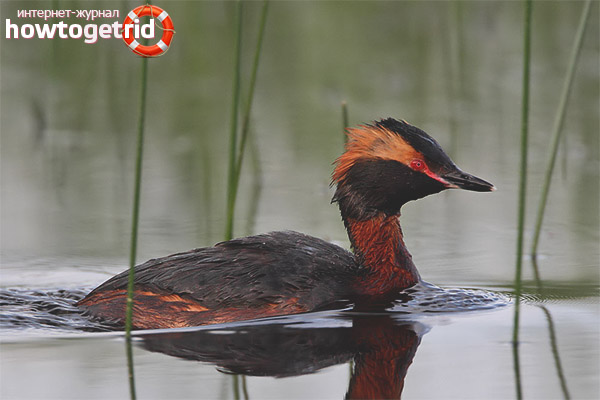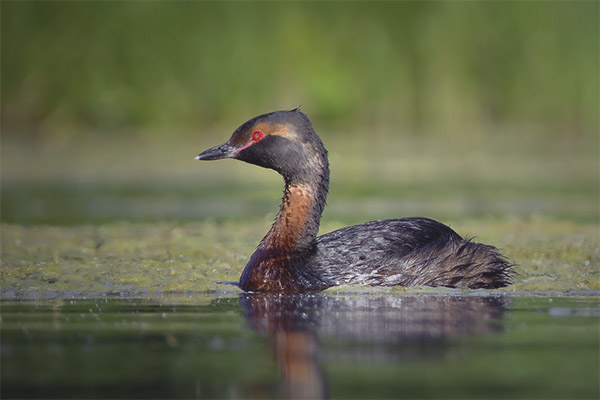The content of the article
Red-necked grebes or Podiceps auritus belong to the grebe-like order and the grebe family.
Description
These small toadstools are about the size of teals. Their height ranges from 31 to 38 cm, and the size of the wingspan is from 59 to 65 cm. Their dimensions and appearance resemble black-necked toadstools; in mating periods, they differ from them by their fiery-red necks, and at this time raised.
Differences are observed in the form of the beak. In females, it is larger and appears to be more even. And in black-necked grebes, beaks are slightly strung up. In winter, they are easily distinguished by the shape of the beak, as well as the color of the head. At this time of year, a separation line passes between the cheeks and the black nape.
In general, their behavior and manner of swimming, they are very similar to each other. However, black-necked grebes have a greater tendency to swim in open waters, including nesting periods.This does not apply to red-headed grebes. They follow a different line of behavior.
Appearance
In winter, the red-necked grebe has a two-tone color, the graphite-colored upper body of the bird is combined with the white bottom and at the same time it has bright red eyes.
The chicks of the red-necked grebes are little different from the chicks of the black-necked grebes. The only difference is the presence of black and white stripes in the neck and head, which look clearer and wider.
Vote
Red-necked grebes own different shrill intonations or create low melodious trills. The sounds that they make can cause various unpleasant emotions to those who have to hear them.
Habitat

The habitat of the red-necked grebes is Eurasia and North America and their forest zones.In the Russian Federation, they are found in the European part from the north. Their nesting does not occur within the suburbs. It is impossible to meet the red-breasted grebe in the Arctic Circle. In general, their habitat is a fairly narrow band, which stretches from the eastern to the western part.
Red-breasted grebes overwinter near the shores of the Azov and Black Sea. They are few in number and in most places quite rare birds. For this reason, the species is considered rare by right.
Way of life
Red-necked grebes are northern birds, they often live near lakes where there are no overgrowths of flood plants, for example, high marshes.
Nesting
Red-necked grebes are monogamous and able to live on several families at once. Sexual maturity comes to them between the first and second years of life.
Red-necked grebes nest more often in pairs alone, much less often, creating dispersed breeding colonies of 15 pairs. Their nesting area can cover about 2 hectares. They never build nests in open waters and do not use to build green plants.The diameter of these nests range from 16 to 23 cm.
Nests prefer to equip the small size of lakes or rivers with abundant coastal vegetation. Masonry, as a rule, do in the month of May. Each of them contains about 5 white eggs about 5.5 cm in diameter. During the incubation period, these eggs become too dirty and turn brown. Red-necked grebes hatch out their chicks for about 21 days, more often longer. Then, mostly chickens of different ages hatch from eggs. Independence they reach at the age of one and a half months and leave the nest.
Nutrition
Character traits
Red-necked grebes are fairly capricious and aggressive birds. They fiercely protect their territory and nest. Able to conflict with their own kind in the most brutal form.
The species of Red-necked Grebe is a rare and very original bird, which is rapidly losing its numbers today.
Video: Red-necked Grebe (Podiceps auritus)












To send